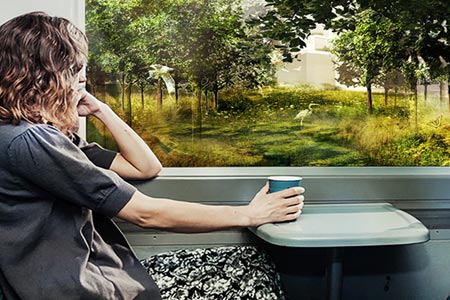The Parco Romana project’s goal is to develop a unique integration model between nature and the city. The Outcomist team developed the project, along with Diller Scofidio + Renfro, PLP Architecture, CRA - Carlo Ratti Associati, Arup, which won the Masterplan to regenerate the Porta Romana Railway Yard. The project was tendered by Fondo Porta Romana, promoted and managed by COIMA and backed by Covivio and Prada Holding.
Architect Carlo Ratti talks to Urban Stories about the extraordinary opportunity that industrial and disused areas offer to Italian cities. The Porta Romana transformation was designed to provide the neighbourhood and the city space with connection and contact that responds to the needs and expectations of contemporary society, which is increasingly attentive to well-being, innovation and sustainability issues.

Carlo Ratti, Founding Partner, CRA – Carlo Ratti Associati
The desire to celebrate these values and the principles of inclusiveness, biodiversity, and resilience gave rise to a project to create an area that connects different and geographically distant areas of Milan which are divided by a disused railway yard. A functional application of the “15-minute neighbourhood” model will provide the necessary services in a strategic area straddling the centre and the suburbs, in continuity with the idea of a widespread city outlined by Renzo Piano in the Regeneration Italy meeting.
Architect Carlo Ratti explained: “Parco Romana is a site that brings together different worlds, combining natural and artificial elements, and is at the centre of the ecological and infrastructural Lombard capital networks.”
The project will be built around a large green area that will develop along the railway line, sustainably redeveloping an existing structure and creating an ecological corridor between opposite points in the city. This will be a multifunctional green space designed to offer citizens and tourists the necessary services within a human-scale framework.
Ratti continued: “Imagine a Suspended Forest, an elevated area with trees, pedestrian paths and communal gardens where collective activities and events can take place for the well-being of the neighbourhood's inhabitants, visitors, and the athletes who will populate the Olympic Village in 2026 and the students who choose the residences built in this area.”

Rendering Piazza Lodi
This substantial natural space will be complemented by the surrounding real estate, which will comprise new constructions and redeveloped historic buildings. This will make up an integrated urban project, where green areas and meeting places (such as squares rising at the intersection of the main pedestrian routes) and spaces intended for residences or offices and co-working spaces will coexist. “Two large urban blocks will overlook this ecological corridor, and a new shopping centre for the city will be built to the east. It will have well-connected buildings that will provide various services to the community. At the same time, residential complexes enriched with spaces designed for outdoor physical activity and places for gatherings will be built to the west. This area will initially host the Milan 2026 Winter Olympics athletes and then be made available to young people, students, and others.”
Read also: Planning resilient cities

Rendering train line
Commitment to sustainability is crucial to all those involved in the development of this Masterplan. Ratti said: “We aim to achieve practical goals in line with the Paris Agreement and the NRP, such as reducing CO2 emissions, through simple actions that can make a difference in safeguarding our planet. We use wood for the construction of new buildings, to lower our carbon emissions, and focus on green technologies for the supply of renewable energy and clean water, promoting sustainable mobility and discouraging the use of cars with the spread of pedestrian zones and cycle paths.”
Parco Romana will be the first significant transformation for the city of Milan after the pandemic. Such an ambitious project cannot do without a strong innovative and digital component. Architect Ratti points out that "the Masterplan’s Digital Twin, a digital model of the project's physical development, allows its management throughout its life cycle, streamlining economic, social, cultural and environmental factors, and enabling to achieve important goals for the city’s benefit."
With the Parco Romana project, between nature, new services and further development objectives, Milan aims to move closer to the coveted model of a widespread city and eliminate the opposition between the centre and outlying areas, offering the community a hyper-connected, sustainable and attractive maxi-space.




